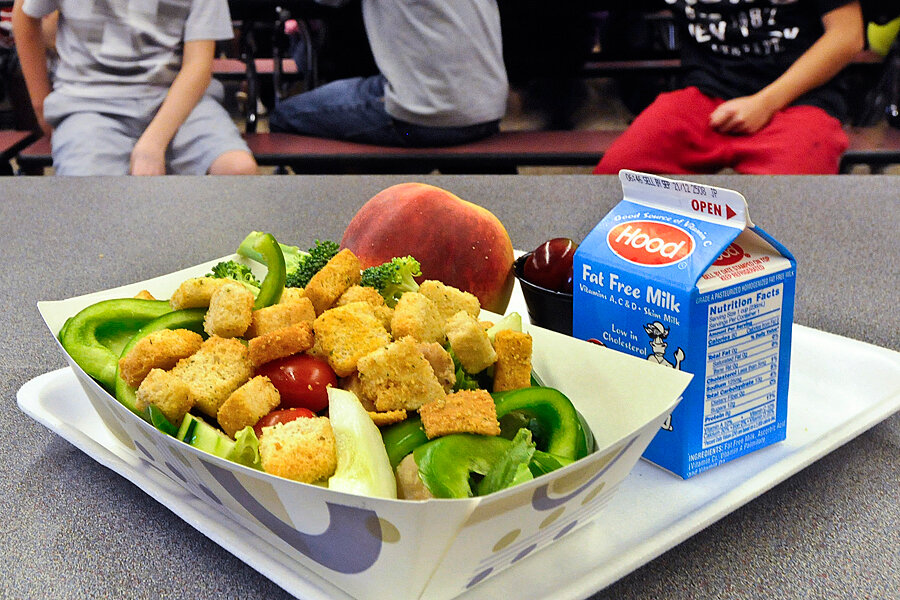Are nutrition standards for school meals too tough? Congress considers tweaks.
Loading...
A food fight is brewing on Capitol Hill.
Stronger nutritional standards for school meals have been phasing in since 2012, touted by everyone from pediatricians to Michelle Obama as a major way to boost children’s health. But now Congress is considering temporary waivers for some school districts or suspension of certain requirements that many districts say will be a struggle to meet.
The School Nutrition Association (SNA), representing 55,000 school nutrition professionals, is leading the push to delay or tweak some of the standards. The group says many students who paid for meals are opting out, revenues are declining, produce costs are rising, and too many kids who are forced to take a fruit or vegetable with their meal are junking the healthier fare – sometimes defiantly tossing it into the trash before they even sit down.
Representatives of more than a dozen groups, including the SNA, met Thursday in Washington to discuss the standards with Secretary of Agriculture Tom Vilsack and Sam Kass, the top White House nutrition policy adviser and executive director of Let’s Move!, the kids’ health campaign launched by Mrs. Obama.
While the SNA supports many standards passed in the Healthy, Hunger-Free Kids Act of 2010, it says some stringent rules are backfiring in some districts that haven’t had enough time to find or create the right mix of products to satisfy kids’ taste buds.
But supporters of the high standards – ranging from the National Parent Teacher Association to a group of past presidents of the SNA – are pushing back, urging that Congress maintain the standards rather than move forward with a waiver bill being considered in the US House as part of the agriculture appropriations process. In that bill, school meal programs that have suffered at least six months’ worth of net losses would be eligible for a one-year delay.
The US Department of Agriculture “has made a lot of concessions already to help districts to comply…. It’s not any time to be retreating on nutrition,” says Jane Wynn, one of 19 past presidents of the SNA who sent a May 27 letter supporting the standards to the relevant congressional committees.
Rules that kicked in July 1 for schools include stricter standards for snack foods and a requirement that all grain products be “whole grain rich,” up from 50 percent in 2012. Whole grain rich means the foods have to have at least 50 percent whole grains. The USDA has granted some flexibility on pasta in districts that have struggled to find whole grain rich options that students will eat, until they can access better products.
The success rate for meeting the easier 2012 standards is still being debated. According to the USDA, 9 out of 10 districts are in compliance. That figure is based on a sample of school menus that met the standards at the time districts applied to be certified for a funding increase of 6 cents per meal.
But this doesn’t necessarily mean success in the broader sense, because they didn’t have to show student participation rates or financial sustainability, says SNA spokeswoman Diane Pratt-Heavner.
Participation in school meals has declined 4.7 percent since 2011-12 overall, with paid participation falling about 15 percent, the SNA reports. In 2011-12, for instance, the Seattle Public Schools had a surplus of about $80,000 in its food program. In 2012-13, produce costs increased about $118,000, and the meal program ended that year with a $258,000 loss.
In addition to the current waiver debate, the SNA has asked for other changes to be considered when the law comes up for reauthorization in 2015. Among them, removing the mandated fruit or vegetable and making it a choice.
Cornell researchers David Just and Joseph Price found that offering students incentives was a more cost-effective way to get them to eat more fruits and vegetables. Simply forcing them to have a fruit or vegetable on their tray led to modest increased consumption, but it significantly increased the amount of food waste. The study was based at 18 elementary schools in two school districts.
Another study, conducted by Harvard researchers at four schools in one urban district, found increased consumption of vegetables and no significant increase in food waste.
Costs and student tastes can be addressed without ditching the standards, maintains Ms. Wynn, a former school nutrition director for Broward County, Fla. There are “so many creative things going on” with districts succeeding in balancing revenues and expenses. A serving of fruits or vegetables can be incorporated into entrees and side dishes; students can be involved in taste tests; and for districts where produce expenses are high, more canned or frozen alternatives are options, she says.
After Thursday’s meeting, Secretary Vilsack announced that the USDA would collaborate with several groups “to develop comprehensive technical assistance plans for those schools who need extra help in order to meet the healthy meal standards.” He noted that $48 million is still available for states to offer training to schools.






